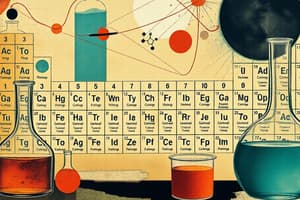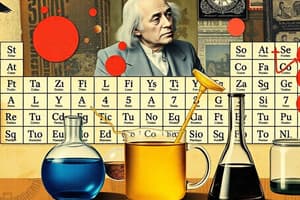Podcast
Questions and Answers
Which factor does NOT affect the reaction rate?
Which factor does NOT affect the reaction rate?
- Temperature
- Concentration
- Color of reactants (correct)
- Catalysts
What describes a state where the rate of the forward reaction equals the rate of the reverse reaction?
What describes a state where the rate of the forward reaction equals the rate of the reverse reaction?
- Reaction completion
- Chemical imbalance
- Reaction initiation
- Chemical equilibrium (correct)
What is the unit that measures the amount of substance, equivalent to Avogadro's number?
What is the unit that measures the amount of substance, equivalent to Avogadro's number?
- Mole (correct)
- Gram
- Kilogram
- Liter
Which type of bond characterizes alkenes?
Which type of bond characterizes alkenes?
What term refers to the substance that dissolves a solute in a solution?
What term refers to the substance that dissolves a solute in a solution?
Which statement accurately describes an atom?
Which statement accurately describes an atom?
What defines a strong acid?
What defines a strong acid?
Which type of chemical bond involves the sharing of electrons?
Which type of chemical bond involves the sharing of electrons?
What occurs during a decomposition reaction?
What occurs during a decomposition reaction?
What does the pH scale measure?
What does the pH scale measure?
Which of these statements is true about exothermic reactions?
Which of these statements is true about exothermic reactions?
Which of the following describes a plasma state of matter?
Which of the following describes a plasma state of matter?
What is the main characteristic of a metallic bond?
What is the main characteristic of a metallic bond?
Flashcards are hidden until you start studying
Study Notes
Basic Concepts
- Matter: Anything that has mass and occupies space.
- States of Matter: Solid, Liquid, Gas, Plasma.
- Atoms: Basic unit of matter, consisting of protons, neutrons, and electrons.
- Protons: Positively charged particles found in the nucleus.
- Neutrons: Neutral particles found in the nucleus.
- Electrons: Negatively charged particles orbiting the nucleus.
Periodic Table
- Elements: Pure substances that cannot be broken down chemically.
- Organized by atomic number (number of protons).
- Groups (columns) indicate elements with similar properties.
- Periods (rows) indicate the energy levels of electrons.
Chemical Bonds
- Ionic Bonds: Formed through the transfer of electrons from one atom to another, resulting in charged ions.
- Covalent Bonds: Formed when two atoms share electrons.
- Metallic Bonds: Occur between metal atoms, characterized by a 'sea of electrons'.
Chemical Reactions
- Reactants: Substances that undergo a chemical change.
- Products: New substances formed as a result of a chemical reaction.
- Types of reactions:
- Synthesis: A + B → AB
- Decomposition: AB → A + B
- Single Replacement: A + BC → AC + B
- Double Replacement: AB + CD → AD + CB
- Combustion: Hydrocarbon + O₂ → CO₂ + H₂O
Acids and Bases
- Acids: Substances that donate protons (H⁺) in a solution.
- Strong acids: Fully dissociate in water (e.g., HCl, H₂SO₄).
- Bases: Substances that accept protons or produce hydroxide ions (OH⁻).
- Strong bases: Fully dissociate in water (e.g., NaOH, KOH).
- pH Scale: Measures acidity or basicity of a solution (0-14).
- pH < 7: Acidic
- pH = 7: Neutral
- pH > 7: Basic
Thermodynamics
- First Law of Thermodynamics: Energy cannot be created or destroyed, only transformed.
- Enthalpy (ΔH): Change in heat content during a reaction.
- Exothermic Reactions: Release energy (heat).
- Endothermic Reactions: Absorb energy (heat).
Kinetics and Equilibrium
- Reaction Rate: Speed at which reactants turn into products.
- Factors affecting reaction rate:
- Concentration
- Temperature
- Catalysts
- Chemical Equilibrium: State where the rate of the forward reaction equals the rate of the reverse reaction.
Stoichiometry
- Mole: Unit that measures the amount of substance, containing Avogadro's number (6.022 x 10²³) of entities.
- Balanced Chemical Equations: Reflect the conservation of mass, with the same number of each type of atom on both sides.
Solutions and Solubility
- Solvent: Substance that dissolves a solute (e.g., water).
- Solute: Substance being dissolved (e.g., salt).
- Concentration: Amount of solute in a given volume of solvent.
- Solubility: Maximum amount of solute that can dissolve in a solvent at a given temperature.
Organic Chemistry
- Hydrocarbons: Compounds consisting of carbon and hydrogen.
- Alkanes: Single bonds (C-C).
- Alkenes: At least one double bond (C=C).
- Alkynes: At least one triple bond (C≡C).
- Functional Groups: Specific groupings of atoms that determine the chemical behavior of organic compounds (e.g., alcohols, carboxylic acids).
Applications
- Biochemistry: Study of chemical processes within and related to living organisms.
- Industrial Chemistry: Application of chemical principles to produce goods in large quantities.
- Environmental Chemistry: Study of chemical processes occurring in the environment and their effects.
Basic Concepts
- Matter is anything that possesses mass and occupies space and exists in four states: solid, liquid, gas, and plasma.
- Atoms, the fundamental units of matter, are composed of three main subatomic particles: protons, neutrons, and electrons.
- Protons carry a positive charge and are located in the nucleus, while neutrons have no charge and are also found in the nucleus.
- Electrons are negatively charged particles that orbit around the nucleus.
Periodic Table
- Elements are pure substances that cannot be chemically decomposed into simpler substances.
- Elements are arranged by increasing atomic number, which corresponds to the number of protons.
- Groups, or columns, of the periodic table showcase elements with similar chemical properties.
- Periods, or rows, indicate the energy levels that electrons occupy in an atom.
Chemical Bonds
- Ionic bonds occur when electrons are transferred from one atom to another, producing charged ions that attract each other.
- Covalent bonds result from the sharing of electrons between two atoms, creating a strong connection.
- Metallic bonds involve a collection of metal atoms sharing their electrons freely in a "sea of electrons," allowing for conductivity.
Chemical Reactions
- Reactants are the starting substances in a chemical reaction that are transformed into products.
- The types of chemical reactions include:
- Synthesis: Two or more reactants combine to form a single product.
- Decomposition: A single compound breaks down into two or more simpler substances.
- Single Replacement: One element replaces another in a compound.
- Double Replacement: Exchange of ions between two compounds occurs.
- Combustion: A hydrocarbon reacts with oxygen, producing carbon dioxide and water.
Acids and Bases
- Acids are substances that donate protons (H⁺) in an aqueous solution; strong acids like HCl and H₂SO₄ dissociate completely in water.
- Bases accept protons or produce hydroxide ions (OH⁻); strong bases like NaOH and KOH also fully dissociate in water.
- The pH scale quantifies acidity or basicity from 0 (most acidic) to 14 (most basic), with pH 7 being neutral.
Thermodynamics
- The First Law of Thermodynamics states that energy cannot be created or destroyed but can be transformed from one form to another.
- Enthalpy (ΔH) refers to the change in heat content during a chemical reaction.
- Exothermic reactions release energy in the form of heat, while endothermic reactions absorb energy.
Kinetics and Equilibrium
- Reaction rate describes how quickly reactants convert to products, influenced by factors such as concentration, temperature, and the presence of catalysts.
- Chemical equilibrium occurs when the rate of the forward reaction equals the rate of the reverse reaction, resulting in constant reactant and product concentrations.
Stoichiometry
- A mole is a unit representing 6.022 x 10²³ entities, used to quantify the amount of substance.
- Balanced chemical equations demonstrate the conservation of mass, ensuring equal numbers of each type of atom on both sides of the equation.
Solutions and Solubility
- A solvent is a substance that dissolves a solute, such as water, while the solute is the substance being dissolved, e.g., salt.
- Concentration measures the amount of solute in a specific volume of solvent, while solubility indicates the maximum amount of solute that can dissolve in a solvent at a certain temperature.
Organic Chemistry
- Hydrocarbons are organic compounds made up exclusively of carbon and hydrogen atoms.
- Alkanes feature single bonds (C-C), alkenes contain at least one double bond (C=C), and alkynes have at least one triple bond (C≡C).
- Functional groups in organic molecules, like alcohols and carboxylic acids, play a crucial role in determining their chemical behavior and reactivity.
Applications
- Biochemistry focuses on chemical processes involving living organisms, emphasizing molecular interactions.
- Industrial chemistry applies chemical principles for large-scale production processes of consumer goods.
- Environmental chemistry studies chemical interactions in the environment and their impacts on ecosystems and health.
Studying That Suits You
Use AI to generate personalized quizzes and flashcards to suit your learning preferences.




